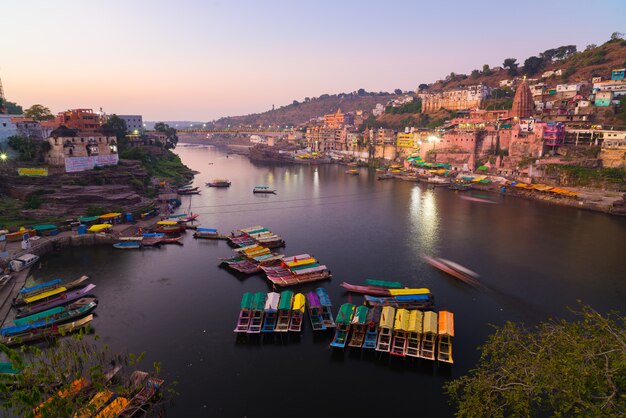| Posted on March 16, 2024 | others
Which two major rivers fall into the Arabian Sea?
@amankumar6752 | Posted on August 27, 2024
An Overview India is blessed with many rivers, most of which are important to the geography, culture, and economy of the country. Among these are two famous rivers that flow into the Arabian Sea, the Narmada and Tapi (also known as Tapti) rivers.
These rivers are of great geographical and cultural importance and play an important role in the areas through which they flow. In this article, these two rivers will be explored, about their origin, course, tributaries, cultural significance and role in the ecosystem and the livelihoods of the people who depend on them. theirs.
1. Narmada River: Lifeline of Central India
Origin and Course
Called the "Lifeline of Madhya Pradesh and Gujarat", the Narmada River is one of the longest rivers flowing through western India. The river originates from the Amarkantak Plateau in Madhya Pradesh and flows through the states of Madhya Pradesh, Maharashtra and Gujarat covering a total length of 1,312 km before emptying into the Arabian Sea.
The river journey starts from the Maikal range and emerges from the sacred Narmada Kund near Amarkantak town. From here the river descends through hills and valleys, creating one of the most beautiful and fertile valleys in India, the Narmada Valley. This valley is home to many plant and animal species and provides livelihood for millions of people.
Branches and Basin
The Narmada River has many branches that contribute to its flow. Its main tributaries are the Hiran, Ursang, Barna, and Tawa rivers. Covering an area of 98,796 square kilometers, the Narmada basin is known for its abundance of arable soil, making it a fertile region for agriculture.

The valley also includes some major urban areas such as Jabalpur, Hoshangabad, and Bharuch. Historically, these cities were important for trade, culture and regional administration.
Cultural and Religious Background
The Narmada River holds a special place in Hindu mythology and is considered one of the seven sacred rivers of India. The river is known as a goddess and is believed to have the power to wash away sins. Narmada Parikrama, a pilgrimage that involves circumambulating the river from its source to its mouth, is considered auspicious by Hindus.
Many temples and religious sites lie along the river, including the famous temples of Omkareshwar and Maheshwar in Madhya Pradesh. These places attract thousands of pilgrims and tourists every year and participate in the cultural and religious traditions of the region.
Economic and environmental importance
The Narmada River is important for irrigation, drinking water, and hydropower generation in central India. The Narmada Valley is one of the most productive agricultural regions of the country, where crops such as wheat, rice, and cotton are widely grown.

Several large dams have been built on the Narmada River, the most important of which is the Sardar Sarovar Dam in Gujarat. This dam is one of the largest dams in India and plays an important role in supplying water for irrigation, drinking and industrial purposes in Gujarat and Maharashtra.
However, building dams on the Narmada has also created major environmental and social challenges. Displacement of local communities, loss of biodiversity and changes in the river's natural flow have led to widespread protests and movements like the Narmada Bachao Andolan.
2. Tapi River: The River of Life in the West
Origin and Route
The Tapi River, also known as Tapti, is another major river that flows to the Arabian Sea. It originates from the Satpura range in Madhya Pradesh, near the town of Multai. The river moves 724 km west, passing through the states of Madhya Pradesh, Maharashtra and Gujarat before draining into the Arabian Sea near the port city of Surat.
The Tapi River is one of the three major rivers that flow to the west of the Indian peninsula, the other two being the Narmada and the Mahi. This river forms a natural boundary between the northern and southern regions of the Indian continent and plays an important role in the geography of western India.
Flows and Banks
The major tributaries of the Tapi River are the Poorna, Girna, and Panjre rivers. The Tapi basin covers an area of about 65,145 square kilometers, making it one of the smallest basins in India compared to the Narmada basin.
Although smaller, the Tapi Basin is fertile and supports a variety of agricultural activities. The area is known for growing cotton, earthworms, and peanuts, among other crops. The city of Surat, located on the banks of the Tapi River, is one of the major commercial centers of India, known for its diamond-cutting and textile industries.
Cultural and Historical Values
The Tapi River, like the Narmada, has cultural and religious significance. This river is mentioned in many ancient texts and is associated with various myths and legends. The city of Surat, located on the banks of the river, is an important commercial port and cultural center.

Surat's rich history as a trading center during the Mughal period, later under British rule, is linked to the Tapi River, which facilitated the movement of goods and people. . The river basin has been an important human settlement area for centuries and has contributed to the region's diverse cultural heritage.
Economic and Ecological Importance
The Tapi River is important for irrigating the agricultural lands of the region. Built on the Tapi River, the Ukai Dam is one of the largest dams in Gujarat and plays a major role in water management, flood control, and power generation.
The estuary near Surat is an important ecological site that supports a variety of marine and bird life. Riparian forests are important for maintaining ecological balance and protecting the coast from erosion.
However, like the Narmada, the Tapi River also faces challenges related to pollution, over-harvesting, and waste. Efforts are being made to address these problems through better water management practices and conservation programs.
Conclusion
The Narmada and Tapi rivers are the two major rivers of India that flow into the Arabian Sea. They shaped the geography, culture, and economy of the regions they roamed and supported millions of people through agriculture, industry, and religion.
Although they remain a valuable resource, the sustainable management of these rivers is essential to maintaining their ecological health and cultural significance for future generations. Understanding the history, importance and challenges these rivers face will help build awareness and strengthen efforts to protect them.